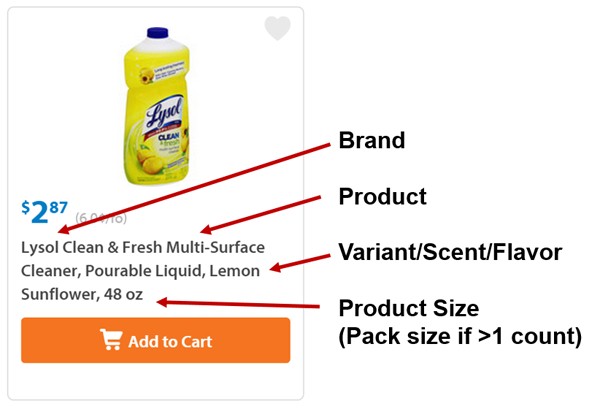eCOMMERCE
SECTION ONE
SECTION TWO
Succeeding in Online Grocery
By Greg Konczyk
Being in the technology and market intelligence business, and devoted to CPG retailing, I always like to hear
from actual shoppers to expand my perspective beyond the data I work with every day. Thanks to a recent
holiday gathering, I started talking with a family member about online grocery shopping, one of my favorite subjects these days.
This person, who is both tech-savvy and a heavy online shopper, quickly and rather forcefully dismissed the concept of online grocery shopping, with statements such as:
“Online grocery shopping is too expensive. I can find better prices in the store.”
“I don’t like not knowing where my food comes from. I like picking out my own produce - who wants green bananas?”
“If I have to sit at home and wait for a delivery, I might as well go to the store. Oh, by the way, the grocery store websites are confusing and it takes just as long to shop online as it does in the store.”
“Did I mention that I often like to pay cash for my groceries?”
How’s that for a personal manifesto against online grocery shopping?!
I think these comments are important to share with retailers that want to establish or expand their online grocery business, so they can understand some of the consumer concerns and address them. The fact that online food and CPG retailing is taking off is not in dispute. While online grocery shopping is still very small at approximately 2 percent of total sales, it will grow to 5 percent by 2018 and to as much as 10 percent by 2020 according to IRI-sourced projections.
Last year was a perfect example of this growth as major retailers, led by Walmart, made significant commitments to online shopping. Walmart and Meijer expanded the markets where they offer online groceries, and Hy-Vee recently announced that all their stores can serve as pick-up locations for online grocery orders. And, purely digital grocery retailers like Peapod and Instacart are also growing, with Instacart now valued at over $2 billion (not bad for a four-year-old company that doesn’t have any food inventory much less a grocery store).
So, how can retailers turn consumer dismissals, like those above, into actionable learnings and guiding principles to capture growth and profitability online? Here are some pointers for a thriving online grocery business model:
Leverage the trust shoppers already have in your brand and brick and mortar stores. Most online shoppers will be migrating from known and trusted brick and mortar stores. I’m a firm believer that the “click and collect” model, where shoppers order online but pick up hand selected and just-in-time packaged orders at a store, shows the most promise. This is particularly true when “click and collect” is supported by key features, such as dedicated pick-up areas with groceries being brought and loaded into your car, mobile alerts and notifications when arriving at the store or scheduling a delivery, as well as the ability to pay with cash (this makes online shopping accessible to an entire segment of shoppers that don’t use credit cards).
Retailers should consider establishing pick-up locations in underserved urban “food deserts,” where shoppers can order online from an established retailer (one without a local brick and mortar presence) and pick-up their orders nearby, as these consumers are often limited in their transportation options. Not only does this promote quality food availability but results in incremental sales, as these customers are unlikely or unable to shop at the actual store. The city of Baltimore has been successfully testing a concept called a “virtual supermarket” with ShopRite, and now has seven of these remote pick-up locations.
Overcome the perception that online shopping is expensive. Retailers can do this by making sure online and in-store pricing is comparable (if not the same), offering free pick and delivery for purchases meeting a reasonable spending threshold, and allowing consumers to use coupons or other incentives online to match what’s possible in store. Online grocery shopping should not be viewed as a premium offering but rather as a shopping alternative on par with the in-store experience.
Be a true and complete food retailer. This means offering fresh categories such as bakery, deli, produce or meat online. There are multiple benefits: unlike packaged goods such as cereal, coffee and snacks, which have many competitors, these fresh categories are hard to match by other non-brick and mortar extension grocery online retailers. Additionally, research has shown that these fresh categories frequently serve as the foundation for shopping trips and are almost always complemented by other categories. Buying fresh fish and a salad will often expand baskets to include salad dressings, grains, sauces, beverages, dessert, etc. Why not capture all items on your website much like you would do in the store?
Use technology to connect with shoppers. Collect data (with proper permission) and use it for a customized and value-adding engagement model. Allow shoppers to make preference selections and keep a history to reuse the information for future online shopping trips - no one wants to be filling out the same information over and over again. This ultimate personalization solves the problem of knowing what size apples the customer wants or how ripe the bananas should be, which in turn leads to increased shopper confidence and satisfaction. Personalization allows you to serve relevant offers and reminders to not only enhance the shopping experience (why search again for a favorite pasta sauce if it can appear as a reminder of a past purchase?), but also drive incremental sales. This personalization should extend beyond the experience on the actual shopping site and include mobile, e-mail and other digital touch points.
Optimize the online shopping experience. Offer a rich, reliable and compelling venue across platforms: website, mobile app, mobile web, etc. Much has been written recently about the preferred mobile shopping venue (mobile web or mobile app). In my opinion, both are important, as they serve different types of shoppers, i.e. repeat and loyal shoppers favor mobile apps and casual/uncommitted shoppers prefer mobile web. The key is not to neglect either so that the shopping experience is uniform and of equal quality. Digital shelf optimization is now a popular concept to help retailers design their websites and apps so that items are organized, filtered and displayed in the most logical fashion, the pricing and checkout process are clear, navigation is seamless and easy, and all the product information (such as nutritional facts) is accessible. The goal is to help shoppers make selections and proceed through checkout in three clicks or less. Lastly, make sure you have a robust search feature so that shoppers don’t have to rely on external search engines (i.e. Google), which will often result in a shopper being redirected to competing retailers based on search results and paid search advertising.
This year will bring more expansion and innovation for the online grocery industry, with existing retailers aiming to grow their revenue and new entrants looking to gain a foothold in this fast-growing arena. While multiple approaches and business models will likely be deployed and tested, the above principles will hold true across all of them, serving as universal beacons to successfully navigate the growing food and CPG e-commerce space.
Greg Konczyk is an executive with IRI Worldwide. More information: www.iriworldwide.com
SECTION THREE


